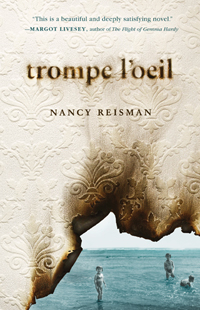Our culture’s stock narrative of trauma is a simple sequence of incident, injury, suffering, and, ideally, some measure of healing. We want to believe that when something terrible happens, we can map the effects in a way that makes sense. Understanding and acceptance must at least seem possible. In Nancy Reisman’s finely wrought novel of family tragedy, Trompe L’Oeil, these comforting notions are exposed as illusions. Here, the horror that befalls an unexceptional, upper-middle-class clan never really recedes with time, never becomes less mysterious and disquieting. It pervades every family member’s consciousness and ripples down the years, creating pain and existential uncertainty even in those not yet born when it happened.
 When we first meet them, the Murphys are a fortunate, likeable family from greater Boston—not wealthy, but sufficiently well off to have a modest home in Newton and a summer place on Cape Cod. James is a rising corporate executive; his wife, Nora, has put her artistic aspirations on hold to care for their three young children—Theo, Katy, and Molly. All is well, at least outwardly. Nora is vaguely restless, plagued by an “emerging shadow” of dissatisfaction with her domestic life and her largely absent husband. James is ready to move up the lifestyle ladder and get a grander house in the far suburbs, while Nora longs for Cambridge, where they spent their early years together.
When we first meet them, the Murphys are a fortunate, likeable family from greater Boston—not wealthy, but sufficiently well off to have a modest home in Newton and a summer place on Cape Cod. James is a rising corporate executive; his wife, Nora, has put her artistic aspirations on hold to care for their three young children—Theo, Katy, and Molly. All is well, at least outwardly. Nora is vaguely restless, plagued by an “emerging shadow” of dissatisfaction with her domestic life and her largely absent husband. James is ready to move up the lifestyle ladder and get a grander house in the far suburbs, while Nora longs for Cambridge, where they spent their early years together.
At this “slippery moment in their marriage,” they sell their Newton house and set off to a vacation in Rome with the children, their future unsettled but only awaiting their choices, or so they assume. Rome reawakens Nora’s passion for her family—“In the shadows of the monuments, in the starker sunlight, she loved all of them”—and James feels a renewed sense of lightness and youth. This happiness is destroyed in an instant, and for all time, when one of the Murphy children is killed in a street accident.
Grieving and shell-shocked, trying to resist the urge to assign blame to one another, the Murphys return home and move permanently into the beach house, a ramshackle place that seems to reflect their collective fragility: “At moments the house might seem to be a constructed set, solid furniture apparently hollow and insubstantial.” The Blue Rock house, as they call it, is like another member of this damaged family, its sweet memories as a summer retreat erased as it is transformed into a sad refuge that receives its own share of damage from the battering elements.
 The death in Rome and its immediate aftermath take place within the first fifty pages or so of Trompe L’Oeil. The rest of the novel traces the very slow disintegration and reformation of the family under the shadow of their loss. Two more daughters are conceived and born in the fog of their parents’ grief. There’s a divorce, another marriage, and finally another death. The power of the novel lies in the way it traces the many ways that first death touches everything—blessings and misfortunes alike—that comes after it.
The death in Rome and its immediate aftermath take place within the first fifty pages or so of Trompe L’Oeil. The rest of the novel traces the very slow disintegration and reformation of the family under the shadow of their loss. Two more daughters are conceived and born in the fog of their parents’ grief. There’s a divorce, another marriage, and finally another death. The power of the novel lies in the way it traces the many ways that first death touches everything—blessings and misfortunes alike—that comes after it.
Yet that tracing ends always, finally, in mystery. Nora and James and their children can never know who they would be without the loss, and so they are strangely indebted to it. As one of the younger daughters, Sara, wanders through Rome decades later, she thinks of the innocent, untouched family she never knew as “memories of a house that exists only in the mind. Is it ever exactly the same house? And if it could exist untroubled? Or if the corollary exile might end?” Sara knows that in that untroubled house, she would likely never have existed at all. What can she make of a tragedy that made her?
Reisman is a writer of unfailingly exquisite prose, and Trompe L’Oeil is filled with the kind of lyrical phrases that echo in the mind. Late August is “the dark peach end of summer.” A dusky sky is “a chalky blanket of indigo.” The sensuality of Reisman’s writing both illuminates and relieves the story’s relentless sadness. Ekphrastic passages on works by Bernini, Raphael, et al., are dropped between chapters, serving as commentary on events while also providing distance and respite. This is an unabashedly beautiful novel with a harsh and difficult truth at its core.

Maria Browning is a fifth-generation Tennessean who grew up in Erin and Nashville. A graduate of Mount Holyoke College, she has attended the Clothesline School of Writing in Chicago, the Moss Workshop with Richard Bausch at the University of Memphis, and the Sewanee Writers’ Conference. She lives in White Bluff.
Tagged: Fiction





